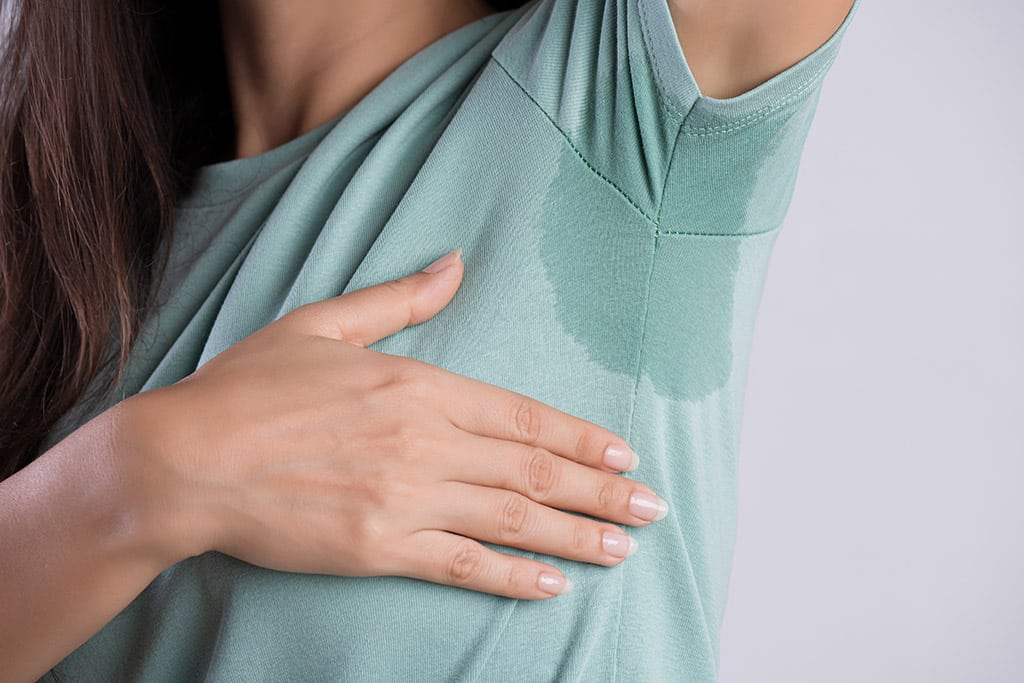What is hyperhidrosis?
Hyperhidrosis is a medical condition that causes excessive sweating. Normally, sweating helps control the body’s temperature, but when sweating occurs too often and in an amount over what is needed to regulate temperature, a person may be diagnosed with hyperhidrosis.
Many patients who have hyperhidrosis sweat from one or two areas of the body. Most often, they sweat from their underarms or palms. While the rest of the body remains dry, these select areas may literally drip with sweat.
Hyperhidrosis can be embarrassing and interfere with everyday activities. Sweat from the underarms often soaks through clothes, causing obvious sweat marks. Sweaty palms can create the appearance of nervousness or lack of confidence in work or social situations.
Causes of hyperhidrosis?
Our body’s nervous system tells the body when to sweat. It’s believed that when these nerves overreact, excessive sweating results. Although science is still trying to better elucidate the condition, hyperhidrosis research indicates that the leading causes of excess sweating are:
- Heredity
- Medical condition such as diabetes and gout
- Adverse effects of medications
- Adverse effect of one’s diet
Hyperhidrosis effects all ethnicities and ages. For many people, hyperhidrosis begins during puberty. Whether you live in a cold climate or a warm one, you can experience hyperhidrosis.
If excessive sweating interferes with your life, our board-certified and fellowship trained dermatologists look forward to discussing the myriad treatments available to you.
Treatment options for hyperhidrosis?
Topical prescription strength antiperspirants
Antiperspirants are considered the first line of treatment for excessive sweating of the underarms, hands, and feet. They are the least invasive treatment option for hyperhidrosis and we often recommend that they be tried first before other more invasive treatments. If topical prescription strength antiperspirants fail, injections with Botox or Dysport may dramatically reduce your sweating in these sensitive areas.
Qbrexza Cloth
Qbrexza is a new topical medication that can be used for excess armpit sweating in patients 9 years of age and older. The medication is supplied on a cloth that is wiped under each arm once daily. Qbrexza, and anticholinergic medication works on the sweat glands directly to decrease sweating. Although it’s relatively simple to use, Qbrexza should be avoided in certain medical conditions like glaucoma, myasthenia gravis, Sjogren’s syndrome among others. It is also not recommended in pregnancy or lactation.
Before Qbrexza, a pill form of the medication was often tried for hyperhidrosis. But because the pill tended to dry eyes and the mouth, it was often very difficult for patients to tolerate long-term.
Botox and Dysport Injections for hyperhidrosis
Botox and Dysport are two additional excellent methods for controlling hyperhidrosis. They work by temporarily blocking the chemical signals from the nerves that tell sweat glands to produce sweat. When the glands don’t receive these signals, sweat isn’t produced and your skin stays dry in the targeted areas. Sweat continues normally in untreated regions of the skin. Prior to injections, the skin is numbed and cooled with ice to increase your comfort. Typically, one session of Botox or Dysport injections is needed to achieve results and sweating gradually returns between 6 and 9 months for most.
Schedule a dermatology consultation
Hyperhidrosis doesn’t need to negatively impact your life. All of our dermatologists at Moy, Fincher, Chipps Facial Plastics & Dermatology look forward to discussing treatment options with you at one of our three offices in Beverly Hills, Encino or Torrance.






